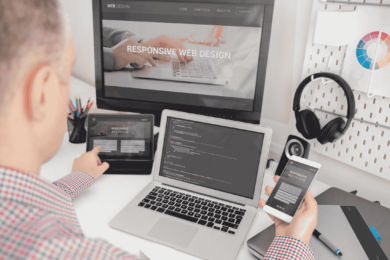Five Marketing Predictions for 2025
Jan 2, 2025By this point, most marketers have become accustomed to the never ending whirlwind of change and evolution in the digital…

Did you know that approximately 15-20% of the global population show signs of neurodivergence, including individuals with ADHD, autism, dyslexia and more? Yet many digital spaces fail to meet their needs, creating unnecessary barriers and here at Extramile, we think it’s time to change that.
As UX designers, web developers and content creators, we all have a responsibility to pave the way for accessibility and inclusivity in the digital space. After all, not only does neurodivergent-friendly design increase satisfaction for users, it also has the added benefit of expanding your reach, by making your content more accessible to a wider audience. It is literally a win for everyone.
Neurodiversity encompasses the natural variations in human thinking and neurological function. It includes conditions such as autism spectrum disorder (ASD), attention deficit hyperactivity disorder (ADHD), dyslexia and more.
Thanks to a growing social awareness of these conditions, no longer are these differences seen as deficits, neurodiversity is now celebrated, encouraging society to reframe its attitude towards accessibility, recognising that neurodivergent individuals may require accommodations in certain environments to thrive.
Navigating the web shouldn’t feel like an uphill battle, but for neurodivergent individuals, it often is. Sensory, cognitive and motor challenges can turn digital spaces into overwhelming and inaccessible environments, making it harder for millions to engage, connect and complete everyday tasks online.
• Sensory Overload
Bright colours, flashing images or auto-playing videos can be overwhelming for those with sensory sensitivities, often leading to stress, anxiety or the need to disengage entirely. Simple choices like muted colours, reduced animations and user-controlled media playback can make a huge difference.
• Cognitive Overload
Cluttered pages, complex layouts and too much information crammed into one space can overwhelm users, making it difficult to focus, process information and complete tasks. Clean, intuitive designs that prioritise clarity and simplicity are key to avoiding this issue.
• Navigational Barriers
Poorly structured websites with inconsistent menus, unclear pathways or lack of organisation can confuse users, especially those with executive functioning challenges. Thoughtfully designed navigation systems, clear labelling and logical structures help guide users effectively through your site.
• Readability Issues
Low-contrast text, dense paragraphs or inaccessible fonts can frustrate users with dyslexia, low vision or other reading difficulties. Offering customisable text options, high contrast and readable fonts ensures everyone can engage with your content comfortably.
With mindful and inclusive design, these challenges can be transformed into opportunities to create digital spaces that are accessible, welcoming and empowering for everyone. Every design decision you make, whether it’s simplifying layouts, improving navigation or enhancing readability has the potential to open doors, build trust and inspire confidence.
Shannon Wright, our Lead Designer at Extramile has shared the following key design principles for creating neurodivergent-friendly websites:
1. Avoid Clutter
Use a minimalistic design with plenty of white space. A cluttered interface can overwhelm individuals with ADHD or other cognitive differences. It’s also just best practice!
2. High Contrast
Use high contrast between text and backgrounds to improve readability for individuals with visual processing difficulties or dyslexia.
3. Test for Colourblindness
Use tools like colour contrast checkers (such as Stark) to ensure your website is accessible to people with colour vision deficiencies. Make sure key elements like buttons are distinguishable without relying solely on colour.
4. Simple and Direct Language
Use plain language and avoid overly complicated text. This helps individuals with ADHD, autism or dyslexia who may struggle with processing dense, technical or abstract information.
5. Limit Flashing or Rapid Movement
Rapid animations, flashing or auto-playing videos can be disorienting or even trigger seizures for individuals with epilepsy. Minimise these elements. Bonus fact – reducing these elements also improves website performance!
6. Avoid Italics
Italicised text can be harder to read for neurodiverse individuals. Stick to normal or bold fonts for emphasis.
Following on from her guidance laid out above, Shannon sums it up perfectly:
“Designing for neurodiversity is all about keeping things clear, simple and flexible. Focus on easy navigation, good contrast, readable fonts and giving users control over things like audio and text size. Make sure your site or graphics don’t overwhelm the senses, and try to offer different ways of accessing info, like text-to-speech or captions. The key is making it feel intuitive and comfortable for everyone.”
At Extramile Digital, we develop custom-built websites that excite, entertain and engage, all while adhering to inclusive design principles. Explore our web design services.
Semantic HTML
Use HTML tags properly to enable assistive technologies like screen readers to interpret your site accurately. Ensure ARIA attributes are applied correctly to improve accessibility for users with disabilities.
Responsive Design
Design websites that adapt seamlessly to all screen sizes. A responsive layout ensures accessibility whether the user is on a desktop, tablet or smartphone.
Optimise Performance
Slow websites can frustrate users. Optimise images, compress files and remove unnecessary scripts to ensure snappy page load speeds.
Inclusive web design benefits everyone, including neurodiverse users. It ensures that your website is accessible, easy to navigate and enjoyable for people with a wide range of abilities and preferences.
By implementing these practices, you’ll improve your site’s overall usability, boost user satisfaction and create a welcoming space for a diverse audience.
Need help making your website neurodivergent-friendly and accessible to all? Contact our team today for strategy-led web design tailored to your needs.

By this point, most marketers have become accustomed to the never ending whirlwind of change and evolution in the digital…

For any business, a website needs to do more than just look good. Whether it’s lead generation, boosting sales or…

Every year, Extramile sends some of its digital marketing team to BrightonSEO to learn advances in the search world, and…

Did you know that out of the estimated 5.44 billion users accessing the web, approximately 64.04% of all traffic can…